Smoked turkey is not uncommon. Mention it in conversation, and most people will respond positively. “Oh, I love smoked turkey,” they’ll say. “My dad/grandfather/brother-in-law/uncle smokes one every year.” I have yet to hear someone praise their mother’s, grandmother’s, sister-in-law’s, or aunt’s smoked turkey, and I suspect it is because the women are busy doing everything else Thanksgiving dinner requires. Sending a man into the yard to prepare the ceremonial bird is a win-win for everyone involved: You get the man out of the kitchen, where he was probably in the way, so you can focus on everything else that needs to be done without worrying about the bird. (I realise this is a very binary way of thinking of Thanksgiving labour, but it is the norm, for better or worse.)
Smoking something on a charcoal grill — the only kind of smoking I’ve ever done — is a fairly engrossing activity. You don’t have to do much, but there’s always a certain amount of fiddling involved, mostly to make sure you keep the temperature where it needs to be. In the case of smoked turkey, most recipes will tell you this is 160ºC, the same temperature you would want your oven when roasting a turkey.
These recipes aren’t complicated: Spatchcock and dry brine the bird, and coat it with a rub before cooking. Set up two zones of heat on your grill, toss one big wood chip on the coals, and place the turkey in the indirect zone to cook at 160ºC until it is “done.” This works fine, but I didn’t do any of that. I did everything the “wrong” way. I left the turkey whole, used a now passé wet brine, and arranged my charcoal in a thick, snake-like formation so the temperature gradually climbed to 165ºC or so throughout the roughly two hour-long cook. In spite of all this, or perhaps because of it, I was rewarded with a flavorful, juicy, beautifully smoked bird with beautifully browned skin.
Why did I deviate from all of these turkey norms?
In my house, I am the dad and the mum, the host and the hostess, the feminine and the masculine. I am going to be the one doing the smoking on Thanksgiving day, but I am also the one who will be doing nearly everything else. My stepmom and a few friends will be bringing side dishes, but the men in my life are useless when it comes to cooking of any kind, and cannot be trusted with something as important as the turkey (or the mashed potatoes, or the dressing, or anything other than rearranging furniture and refilling my beverage). I wanted to set myself up for success, with a turkey that could be left alone for nearly the entire cook, without having to worry about the grill getting too hot or the meat drying out.
Why a wet brine?
Wet brines fell out of fashion a few years ago, and I understand why. Wet brines are, for the most part, far less efficient than their dry counterpart. I am almost always a dry brine gal, unless we are talking about poultry, because buttermilk is wet, but also because of something Samin Nosrat said when I asked her about the topic three years ago:
To be completely honest, while wet brining does fill the bird with water, I do feel like the whole point is that a lot of the time is that turkey’s dry, so if we’re getting some water in there and it’s flavored with salt, and delicious flavourings, then what’s the problem?
I couldn’t think of a problem then and I can’t think of one now. I use this buttermilk brine every single year, and every single year I serve juicy, flavorful turkey with beautifully browned skin. The acid in the buttermilk tenderizes while the proteins promote browning, and the extra moisture ensures the breast meat stays moist, even after over two hours of cooking.
Why didn’t I spatchcock this bird?
A lot of people shy away from spatchcocking for aesthetic reasons, but I don’t care about that. I chose not to spatchcock my smoked turkey for two reasons: ease and charcoal. A whole turkey is a lot easier to get on and off the grill than a floppy bird without a back bone, but keeping the bird whole keeps the breast meat up and away from the super hot coals. A two-zone set-up effectively turns your grill into an oven, but the part of the bird that’s closest to the coals is going to get a little direct heat no matter what. By angling the legs and thighs towards the coals, the dark meat gets to cook a little faster, and the white meat stays slightly elevated, away from the scorching direct heat coming off the coal, which is exactly what you want. (Dark meat — such as legs and thighs — needs to be cooked to at least 73ºC for all that connective tissue to break down, but breast meat dries out if it gets much over 68ºC.) This configuration also means the dark meat gets most of the smoke, which works out, because white meat enthusiasts are the most likely to complain if the turkey flavour gets overshadowed by smoke flavour.
Why the snake?
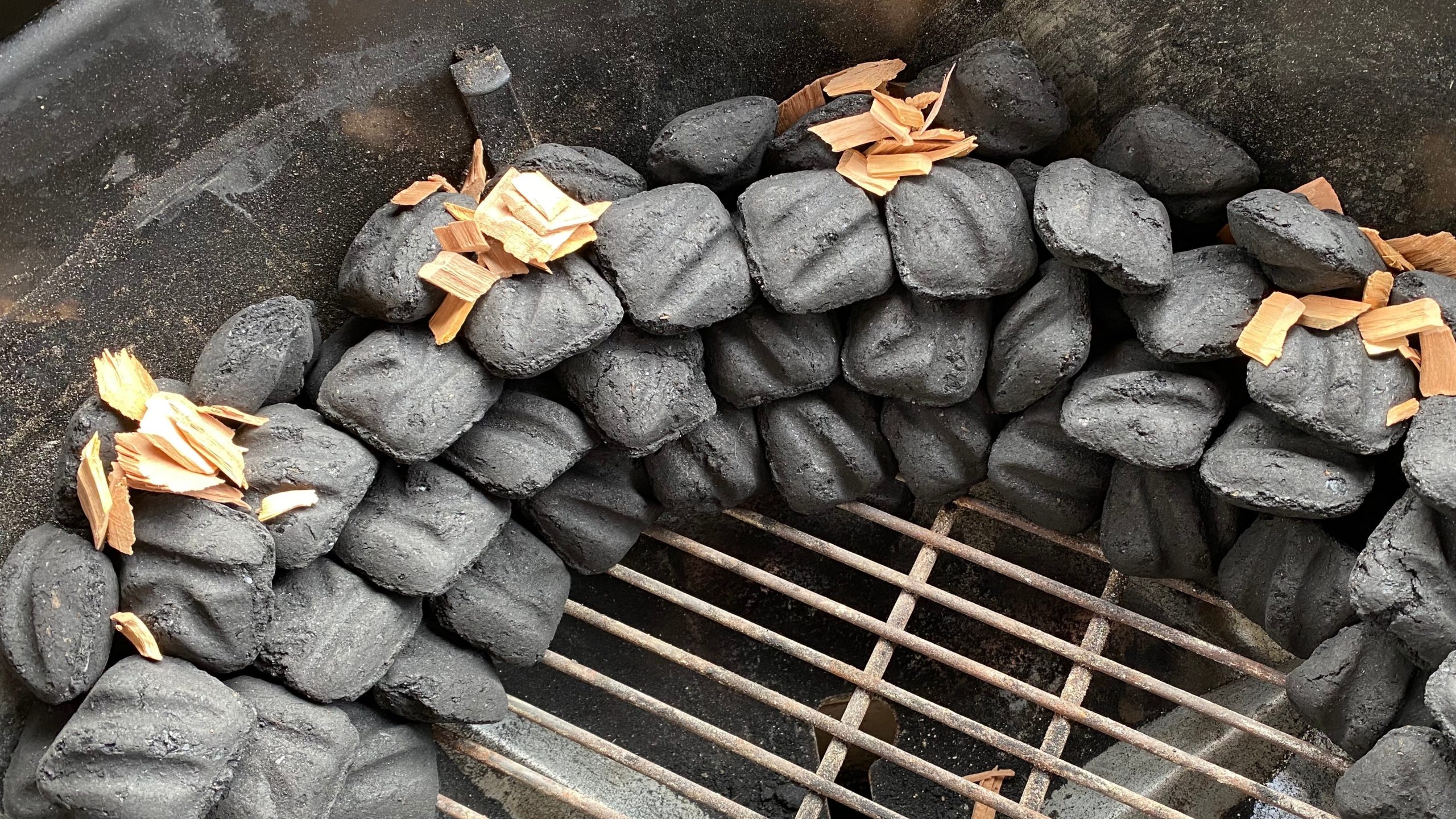
The snake is a charcoal arrangement most commonly used for low and slow cooks, like a smoked pork shoulder. It’s not usually recommended for turkey, because — at least in the traditional two-by-two charcoal formation — it doesn’t get your grill much hotter than 140ºC, which lengthens your cook time significantly. Several recipes claim you have to reach a temp of at least 160ºC to get the skin browned, but I tried a traditional snake with the first test turkey, just to see what would happen, and the skin was perfectly fine. (The five-hour cook time, however, was not fine.)
Even though the classic two-by-two snake wasn’t workable for time management reasons, the ordered nature of the snake was still deeply appealing, as was the slower, gentler cooking temp. I knew piling a chimney full of hot charcoal on one side of the grill, plopping the turkey on the opposite side, and fiddling with the vents to keep the temp at 160ºC would not be conducive to preparing the rest of the meal without losing my entire mind, so I did a sort of hybrid method, creating a thicker, taller snake on one side of the grill. Instead of a two-by-two configuration, I arranged the briquettes in three layers: The first layer was three briquettes deep, and the middle and third layers were each two deep. I made my snake 18 briquettes long (because I didn’t know how long the cook would take and was worried about running out), but this was overkill. You could get away with 10 or 12 for a 5 kg bird, no problem.
I filled my charcoal chimney one third of the way full with briquettes, and lit a starter cube underneath. Once the briquettes were mostly ashed over, I dumped them at one end of the snake, and placed a drip pan on the coal grate, with one of the shorter edges pointed towards the coals. I filled the pan halfway with boiling water (about a litre), set the grill grate over the coals, and placed my brined turkey on the grill, with its butt pointing toward the centre of the snake. I put the lid on, with the top vents facing opposite the coals, and made sure both the top and bottom vents were fully open to allow maximum airflow. The temperature gradually climbed to 330℉ over the course of the next couple of hours, gently heating the turkey before browning the skin towards the end of the cook.
How much wood did I use?
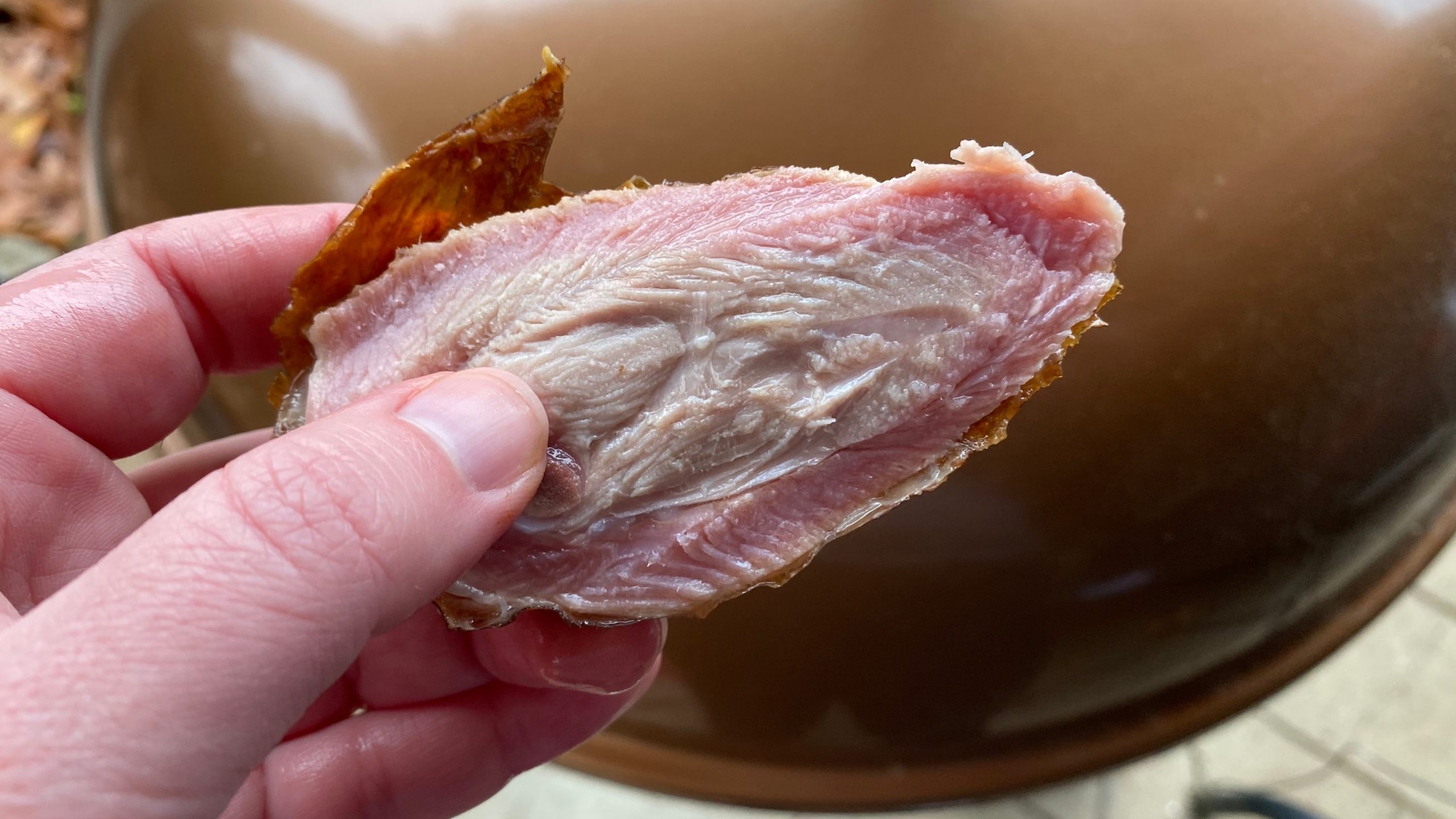
Most smoked turkey recipes caution you against using “too many” wood chips because the smoke flavour can “overpower” the turkey’s flavour. Honestly, who gives a fuck? I’m not incredibly precious about preserving turkey’s natural flavour. I want my smoked meats to taste noticeably smoked, otherwise I might as well use my oven. The oft-recommended “one large chunk” of wood is a bit too timid for my tastes. I set out several small handfuls of chips every three briquettes, but only two of them ended up getting burnt. This, as it turns out, was a good amount of smoke, though I could have taken even more and been happy. You are more than welcome to start with a single large hunk of wood if you want the turkey flavour to shine, but two large chunks, or two small handfuls of smaller chips, will give you a beautiful smoke ring around the dark meat while gently smoking the breasts.
Use a thermometer (or three)
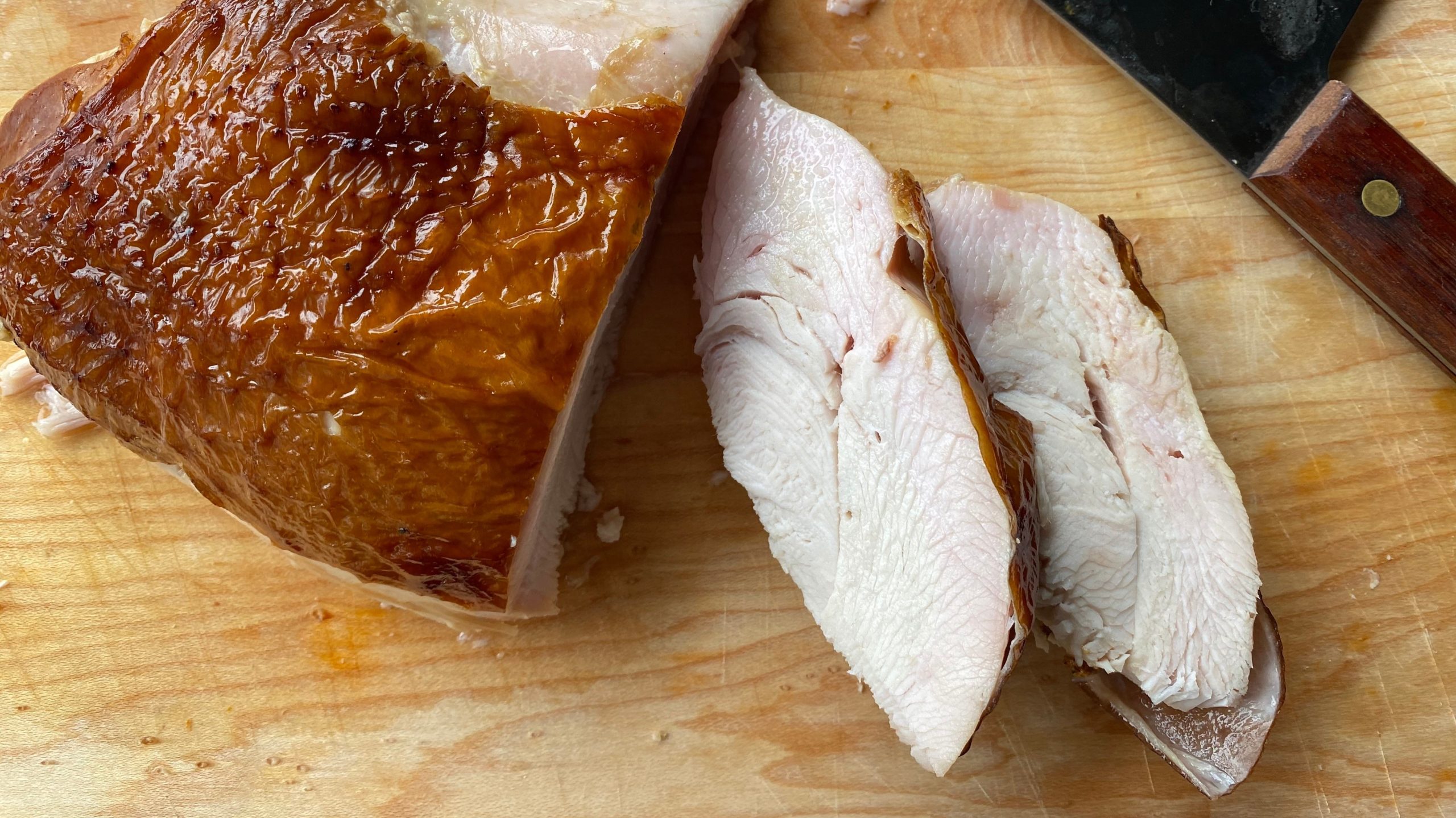
I never recommend cooking meat of any kind without a digital thermometer, but it is imperative when you’re cooking a turkey. I use a dual-probed grill thermometer, so I can keep an eye on the turkey temp and grill temp (that little dial on top of the grill lid is not to be trusted), but you could probably get away with a single thermometer in the thickest part of one of the breasts.
You will, however, want to temp the turkey in a few places before taking it off the grill. Unlike pork shoulder, turkeys are not big hunks of solid meat — they’re irregularly shaped, with parts sticking out all over the place, so poke the bird in a few places with your thermometer to make sure it’s heated to at least 68ºC throughout the breast. My probe thermometer tried to tell me I reached this temp in a mere hour, but it turned out I had pushed it too close to the bone, and the real temp was 45ºC. Always temp in more than one place is what I’m saying.
How to smoke your turkey the “wrong” way
Enough theory, let’s cook a bird. To smoke your turkey the “wrong” way, you will need:
- 1 turkey, no larger than 5 kg (Mine was 5, and it took two hours and 15 minutes to cook.)
- 8 cups of water
- 1 cup of salt
- 1/2 cup of sugar
- 10 smashed garlic cloves
- 1 bay leaf
- 8 cups of buttermilk
- Charcoal and a fire starter
- 2-3 handfuls of wood chips, or two large chunks of wood
- 1 litre of water (for the drip pan)
Brine the turkey the day before Thanksgiving. Place the water, salt, sugar, garlic, and bay leaf in a large sauce pan, bring it to a boil, and stir to dissolve the solutes. Let cool completely, then add the buttermilk to the brine. Place the turkey breast side-down in a brine bag or food-safe plastic container, and add the brine. (Don’t worry if the back sticks out a little, as long as the breast and legs are submerged.) Let brine in the fridge for 24 hours, or as close to 24 hours as possible.
If you’re cooking a turkey in the 5 kg weight range, start setting up your grill three hours before you plan to sit down for dinner. Take the turkey out of the brine and pat it dry with paper towels, then turn your attention to the charcoal. Start by arranging the charcoal along the edge of the grill on top of the charcoal grate. You want the first layer to be 10 briquettes long and three deep, with two additional two-briquette layers on top of the first. Place a small handful of wood chips every two or three rows of briquettes, starting about two in, for a total of three small handfuls. (Use two handfuls if you don’t want a heavily smoked flavour.)
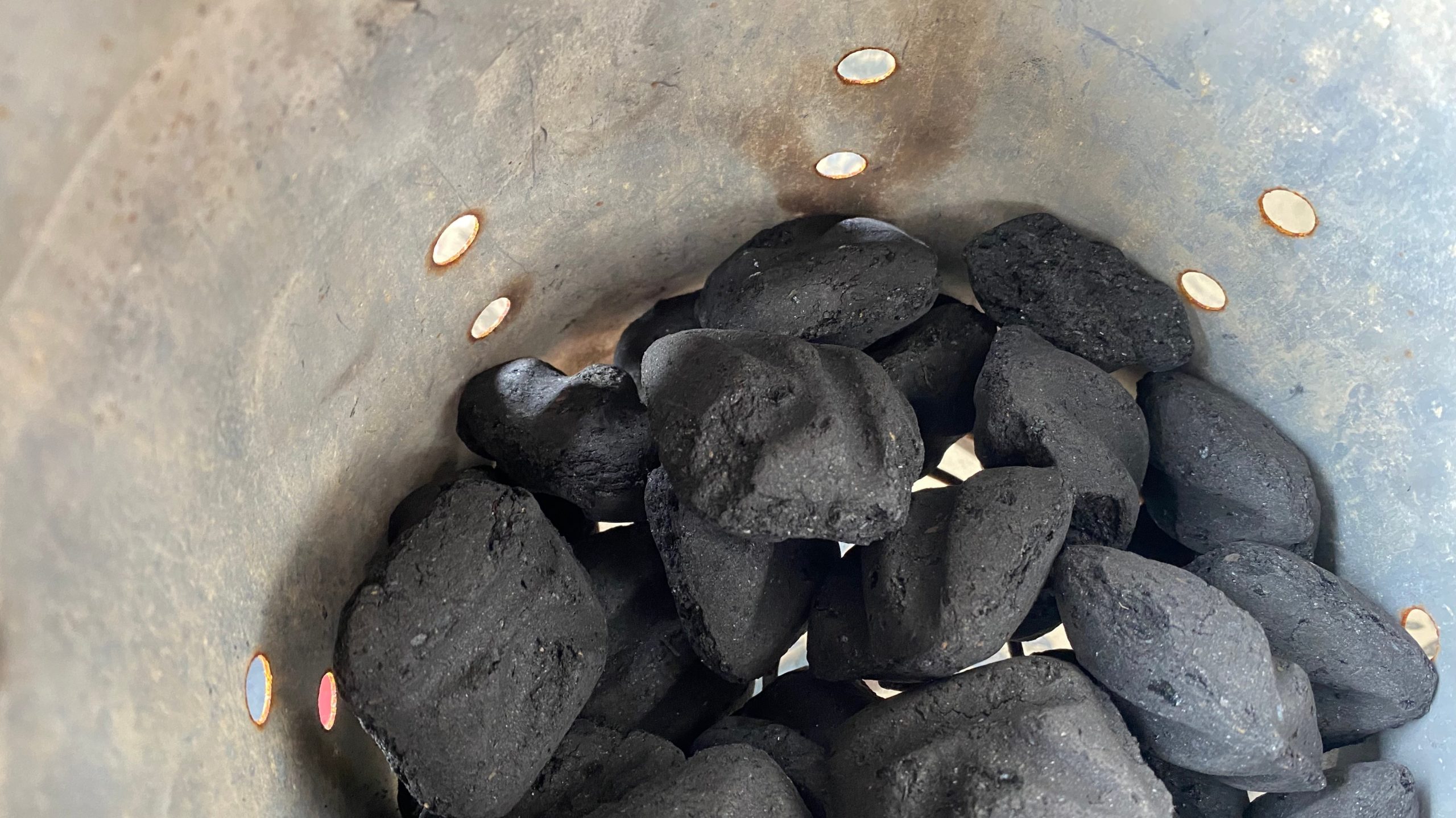
Fill a charcoal chimney about a third full of briquettes. (They should reach the second air flow hole in a standard Weber chimney.) Set a lighter cube or wadded up newspaper in the centre of the grill on top of the charcoal grate, light it on fire, and set the chimney over it. Bring a litre of water to boil when the tips of the briquettes start to get ashy. Once the briquettes are almost entirely ashed over, dump them at one end of the snake, and set the drip pan on the grill grate, with one of the short edges of the pan facing the centre of the snake. Pour the boiling water into the drip pan, set the grill grate in the grill, and go get your turkey.
If you have a grill-safe probe thermometer, stick it in the thickest part of the breast, making sure it’s not touching the bone. If you have a dual-probed thermometer, set one probe next to, but not touching, the turkey so you can keep an eye on the temp toward the end. Set the turkey over the drip pan, with its butt pointing towards the centre of the snake. Put the lid on the grill, and make sure both the top and bottom vents are fully open. The temperature will gradually rise over the course of a few hours, gently cooking the bird and infusing it with a bit of smoke before hitting a skin-crisping temp of 165ºC or so. (Check it about an hour and a half in and close the the top vent a little bit if it looks like it’s going to get much hotter than 165ºC.)
Let the turkey cook until the thickest part of the breast reaches a temperature of 68ºC (the dark meat should be a little hotter — around 73ºC or maybe a little higher). Make sure you temp the bird in a couple of places before you take it off the grill to make sure it reaches 155℉ throughout the entire breast. Remove the turkey from the grill by sticking a large, sturdy wooden spoon or spatula in the cavity, then use a second, large spatula to lift it off the grates. There is some disagreement as to whether resting the turkey truly helps the juices redistribute (both Amazingribs.com and the people at SnS recommend serving the turkey hot off the grill with as little resting as possible), but I usually let mine hang out at room temperature for at least 2o minutes so it’s cool enough to carve without discomfort. Serve to your many hungry guests, along with all the wonderful sides you prepared. With so little tinkering required for the turkey, the whole meal is sure to be exquisite.
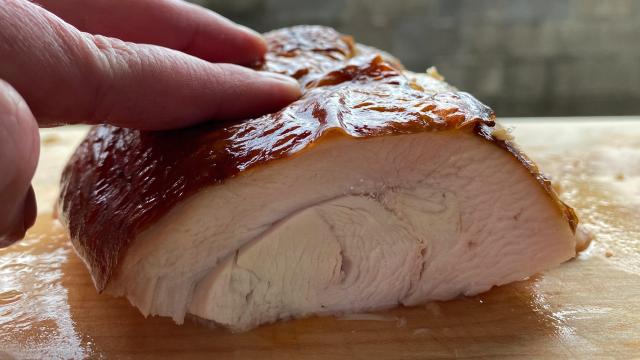
Leave a Reply
You must be logged in to post a comment.